- remind me tomorrow
- remind me next week
- never remind me
The X Button
Marvel Combat
by Todd Ciolek,

The old Nintendo Entertainment System, false god of any '80s kid, enjoyed games based on all sorts of movies and TV series. The games rooted in classic literature were much rarer. They were also awful, from Seta's mundane The Adventures of Tom Sawyer to Bandai's inscrutable Dr. Jekyl and Mr. Hyde. In those days, no one would want to create a game for F. Scott Fitzgerald's epochal The Great Gatsby. Those days are over.
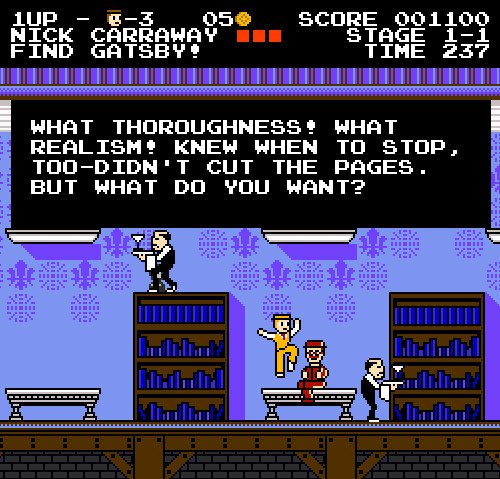
This isn't a genuine Great Gatsby NES game: it's just a very clever Flash construction that perfectly simulates the conceits of old NES platformers. But what I truly appreciate is the author cooking up a backstory for the game, complete with a stained manual, cover art, and a story about finding it all at a yard sale. No NES mock-up is complete without some retroactive nostalgia.
NEWS
ARCANA HEART 3 COMING HERE, BUT ONLY FOR PS3
There was a bit of debate over whether Aksys Games would release Arcana Heart 3 over here. The publisher was the most likely candidate, given Arc System Works' involvement with the game's console version, but Arcana Heart 3 is afroth with super-cutesy and oft-sexualized female fighters, and some thought it too much even for the company that released Record of Agarest War with a body pillow and boob-gel mousepad.

Well, Aksys isn't shying away from Arcana Heart 3. It will arrive as a PlayStation Network download in the spring, when we'll see just how many fighting-game fans grab the game in spite (or because) of its ultra-cute, all-girl roster. Admittedly, there's a lot to explore in the game: each of the 23 fighters can use 23 different Arcana spirits for various special moves, and matches involve a lot of aerial maneuvers and combos.

There is, however, one curious thing: Arcana Heart 3 was released for both the PlayStation 3 and Xbox 360 over in Japan, and the PlayStation 3 version was region-free. So Aksys is only localizing the edition of the game that a lot of Arcana Heart fans already imported. There's no word on a download-only Xbox 360 release, but I can't imagine Microsoft banning Arcana Heart 3 at this stage.
UNDER NIGHT IN-BIRTH IS THE NAME OF AN ACTUAL GAME
French-Bread is an interesting study in the nebulous land between legitimate game developers and indie studios. They originally created Melty Blood as a fan-made fighter based on Type-Moon's Tsukihime series, but Melty Blood grew beyond the doujinshi sector. It was released in arcades and on the PlayStation 2, establishing itself as a relatively respected fighting game. Hell, you can even play it in New York City's Chinatown Fair, last I checked, so it's hard to think of it as an indie fighting game on the same level as Arm Joe and Destruction Desire.
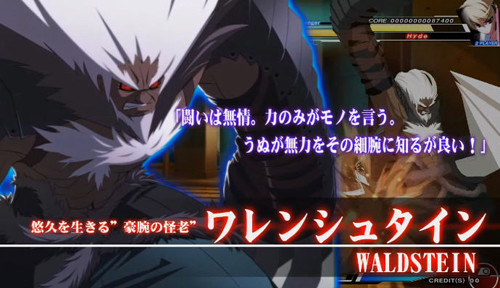
Now French-Bread has a new, completely original fighting game in the works, and they're calling it Under Night In-Birth. Perhaps it's supposed to be “Under Night Inverse,” but whatever it's called, it's coming to arcades by the end of the year. The first trailer shows some fairly slick sprite work, though the game's apparently “original” only in the sense that it's not tied to an anime or visual novel. The four characters revealed so far seem standard fighting-game archetypes, with Carmine looking a lot like Freeman from Mark of the Wolves, while Waldstein is a strange fusion of Red Earth's Leo and Darkstalkers' Hsien-Ko. One must hope that it has some new gameplay ideas like Melty Blood's EX Shielding. At the least, that'll keep insufferable fans from calling the game “stillborn.”
For those who prefer anime-style fighting games with even stronger anime links, there's Shin Koihime Musou Arcade Edition, an upcoming fighter based on a line of visual novels and its anime and manga descendants. The series adapts the Chinese classic Romance of the Three Kingdoms by turning all of its characters into anime girls, which would be notable if Ikki Tousen and several other anime franchises hadn't already done the exact same thing with equally lousy results. Koihime Musou also comes from BaseSon, and the last fighting-game crossover that company sponsored was a swiftly forgotten horror called Twinkle Queen.
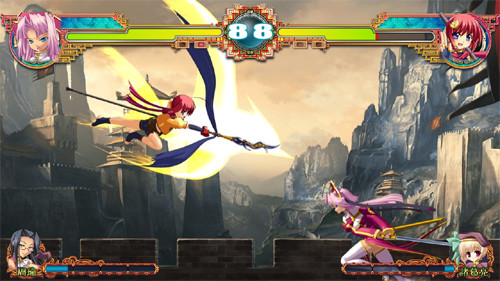
Developed by RCI, Shin Koihime Musou has…er…well, the backgrounds look decent. The character art is hideous and the in-game sprites are mundane, though we all know that gameplay makes a fighting game for many fans. Not to judge this before it's even shown to the public at this week's AOU arcade show, but I doubt this will be the next breakout hit among lower-level fighting games.
CAPCOM FIGHTERS ON PSN, BUT MOSTLY IN JAPAN
As a pure coincidence, Capcom released a bunch of fighting games on the Japanese PlayStation Network just as Marvel vs. Capcom 3 arrived. The PlayStation versions of Darkstalkers 3 (a.k.a. Vampire Savior), Cyberbots, and Star Gladiator are now available to anyone who finagles Japanese PSN downloads, though there's no sign of them on the American network. Darkstalkers 3 is relatively popular, though, and some people may remember Star Gladiator as Capcom's first 3-D fighter and blatant Star Wars homage, right down to the wookie and evil space knight. English versions of both games are already on hand, but the same doesn't go for Cyberbots. While the arcade version was translated, the PlayStation and Saturn ports weren't, and they'd need some extra localization work. Capcom could just release it untranslated, of course, and I wouldn't complain if they did.
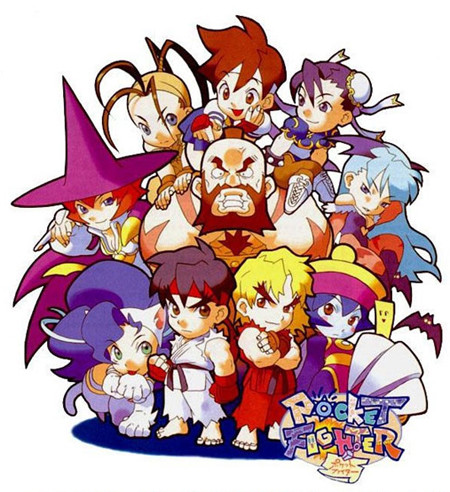
Capcom did release Pocket Fighter for the North American PlayStation Network. A hyper-cute parade of big-headed Capcom characters and in-jokes, it's well worth buying for anyone who likes Street Fighter and Darkstalkers (and the seldom-seen arcade brawler Red Earth) beyond the punching and kicking bits. As that describes me perfectly, I bought the PSN release even though I already have the arcade version of it (called Super Gem Fighter Mini Mix) in the Street Fighter Alpha Anthology. Why? Because the PlayStation's Pocket Fighter has more modes and at least one new background full of Capcom characters.
There's one catch: the PlayStation Network version of Pocket Fighter won't run on PSP. It's just for the PlayStation 3, so your morning train ride won't be brightened by seeing Felicia turn into Mega Man. Not that I'd play games on the train, because that's for nerds.
IN BRIEF: DISSIDIA BONUSES AND A CANCELED MARVELOUS RPG
Capcom isn't the only company to bundle fighting-game characters as pre-order incentives. Anyone who reserves Dissidia 012 Final Fantasy gets two extra fighters packed into the game: the Kingdom Hearts version of Cloud (basically Cloud with a cape and a bat-wing) and the Enforcer version of Tifa (basically Tifa with an open-backed shirt designed by Yoshitaka Amano). I wouldn't be surprised if both version can be bought after the fact, along with more interesting alternate costumes.
Good news: Marvelous, the Japanese company that owns Harvest Moon and some less notable series, turned a profit in 2010. Bad news: That didn't keep Marvelous from canceling a big-budget RPG for the PlayStation 3 and Xbox 360. Marvelous didn't specify what the game was, and the company didn't announce any major RPG titles last year. All we know is that the company took a $3 million loss when the game was canned. Maybe it was for the best after Arc Rise Fantasia didn't take, but it bothers me when games die unknown.
INTERVIEW: JONATHAN KLEIN ON MARVEL VS. CAPCOM 3
Marvel vs Capcom 3 was a long time coming. A surprising long time, in fact, when one considers the recent surge in comic-book superhero movies and the enduring popularity of the ten-year-old Marvel vs. Capcom 2. No matter, because Marvel vs. Capcom 3 is out this week, and it's drawing in all sorts of players by giving them the chance to beat up Nathan Spencer from that unappealing Bionic Commando remake. Oh, and they can also indulge in a massive brawl with 36 characters from the histories of Marvel and Capcom.
That's an imposing lineup for a fighting game, and Capcom and Marvel turned to New Generation Pictures to record all of the various quips and battle cries heard during matches. Jonathan Klein, vice president of New Generation Pictures, told us just what went into the voice acting for Marvel vs. Capcom 3.
How did recording Marvel vs. Capcom 3 differ from recording Street Fighter IV? Is the mid-fight banter from the characters different in tone or length?
The process of recording was essentially the same as how we did Street Fighter IV. Each actor came in separately to record their lines. However, since we were dealing with Marvel comics characters, we had to be extra careful to make sure the tone and dialogue from the Marvel characters were true to their personas, as well as having the Capcom characters sound like they should in their own respective games. Plus, we had to be sure that each person's taunts between the Marvel and Capcom characters would sound like they were really taunting each other directly and not just some general shout-out. The script dialogue that Marvel writer Frank Tieri had given us to work with was excellent, so that made it easy to do. It was incredibly fun to record. And it helped a lot that many of the Marvel actors had already played these characters in the different animated TV series or movies, so they knew their roles well.
But since voice director Taliesin Jaffe and I are huge comic book geeks, we really wanted to put our own little touch in there as well. We did get our chance to contribute some script lines for the recording. One of the things I think I'm most proud of is that we got to re-write some of tag-ins for the characters. Tag-ins are when the player switches between different characters during the battle; the character shouts out the name of the other character they want to replace them in battle.
Originally, characters like Hulk and Spider-Man simply called out everybody's proper name. But I had talked with Chris Baker at Marvel and we both agreed that the Hulk has a hard time even remembering the proper names of heroes in the Marvel Universe - when Bruce Banner is not in control of the Hulk's mind, that is - let alone the names of a whole bunch of new characters from the Capcom universe. So I asked if we could start having some of the Hulk's tag-ins use "Hulk speak." Chris happily agreed. So I went through my quite large Incredible Hulk comic book collection to research what names the Hulk would use for the Marvel heroes. The Hulk has called Iron Man "Metal Man" frequently, Wolverine "Puny Man" on several occasions, and he even called Thor "Goldilocks" in old issues of the comic book, so we used that in the game. Then we tried to think of what the Hulk would call certain Capcom characters. The Hulk usually gives people's names based on their appearance, so it was a lot of fun coming up with those. Who wouldn't want to call Viewtiful Joe “Funny Helmet Man”?
Spider Man was another case where we did some tag-in line changes, because Spider-Man uses his mouth as a weapon almost as much as his super powers. He uses verbal barbs to annoy those he's fighting against and even those he's allied with. I loved that we got him to call Wesker by his first name. Nobody but Spider-Man could do that. We wrote a bunch of great tag-ins for Spidey, even a couple of pre-battle taunts. I'm not sure which ones they used, other than "Albert" (Wesker), but hopefully some of them will show up in the final game.

How much input did Marvel have in casting the voices for their characters? Were most of the parts already cast for other Marvel productions?
Marvel sent us the entire cast list of actors they wanted for all of their character voices. Most of them were the actors who were voicing, or had voiced, the characters in the current and recent cartoons and video games. It was our job to contact their agents and get them on board with the project. But it was a bit difficult for us because we weren't allowed to tell the agents and the actors what role or game they were going to be doing before they agreed to work on the project. This all was due to the secrecy Capcom wanted to prevent people from knowing about the game or having the game's roster of characters getting out. I would be calling agents saying, “We are interested in using [actor name] for a video game project.” And the agent would say “What's the project?” and I would have to tell them “I can't say because I'm under a non-disclosure agreement”, then they'd ask “What's the role?” and I'd have to repeat the same thing. So the agents would start asking me questions like “Is it a pornographic game?” or “Would my client do something they would consider offensive in the game?” or “How much screaming is involved in the game?”
It eventually became a game of 20 Questions with the agents, because I couldn't tell them what it is, but I was allowed to say what it isn't. Somehow we were still able to get everybody that was on Marvel's list. When the actors came in to work on the game, we finally were able to tell them what they were doing at that point. Many were surprised, but very happy about it, since a lot of them were MvC2 game players or very attached to the roles they played for Marvel. I do know some form of the roster eventually leaked, but it was way after we finished recording.
How did you choose voices for characters who didn't have previously established English-language actors, like Morrigan, Felicia, Hsien-Ko, Mike Haggar, and Taskmaster?
Well, it was an audition process. We auditioned actors from all over the US, and even Canada. Of course Taliesin and I had some actors in mind for certain characters when we first auditioned them. We presented several of the best candidates for each of the characters, but the final casting choice was made by Mr. Niitsuma and the Capcom game development team.
What characters did you personally want to see included in the game?
I am happy with all the characters that Capcom and Marvel included in the game. Taliesin and I already have a long history with all the Street Fighter characters, having worked on Street Fighter IV and Super Street Fighter IV. So it was great to re-introduce Mike Haggar back into the modern world of fighting games. I've been a fan of the Darkstalkers games, so it was great to see them represented. It might have been interesting to see somebody from the Ace Attorney series in the game, although I wouldn't know what their move set would be or what kind of special attack they would use, so it seems difficult to incorporate.
On the Marvel side, I can't say I was disappointed by any of the characters they selected. I've been reading comic books for more than 30 years, so I know all the characters they included quite well. They created a nice balance between bringing back many of the classic characters from MvC2, and the earlier games, while introducing a bunch of new characters that are certainly relevant to the Marvel storylines in recent years. While people who aren't avid comic book readers may not recognize some of the new characters, they create a lot of diversity and unique play-style opportunities.
But if I had to nit-pick, I'd would have love to have seen Doctor Strange in the roster simply because you've got two of his mystical arch-enemies, Dormammu and Shuma Gorath, in the cast. And we should not forget that Doctor Doom is in the game, who is a powerful mage as well as a brilliant scientist. So with three Marvel magic-using bad guys, you need at least one Marvel magic using good guy. So either Doctor Strange, or maybe Aunt May...because I believe she was the herald of Galactus in one issue of Marvel Team Up during the '80s, so she'd perfectly fit in the game, since Galactus is the final boss.
I'm kidding about Aunt May, but I think I'd like having Squirrel Girl in the roster because she could be taken as both a joke character and an awesome threat. Unfortunately she's a very divisive character among players. Every hardcore player who wants her would demand her to be god-tier, since she's defeated such heavies as Thanos, Fing Fang Foom, and Doctor Doom in the comic books. But every hardcore player who hates her would complain that she's either a "cheap boss" or just "broken.” But that's the problem with choosing a limited number of characters from two companies who have a huge stable of characters; whoever they choose, somebody is not going to be happy about it.
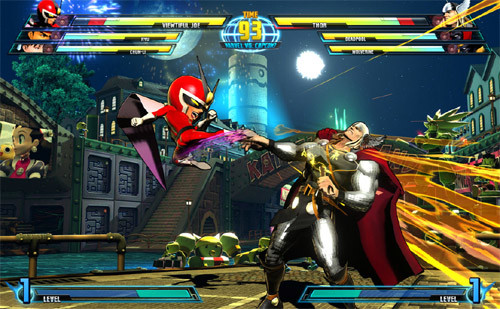
How long does it usually take to record all of the voices for a fighting game, compared to an RPG?
An RPG title for the Xbox 360 or PS3 could take between two to four months, depending on the amount and complexity of the dialogue. Fighting games usually take a lot less time simply because there is a lot less dialogue for each actor. This project took about four weeks to completely record.
Do you find Japanese game companies easier to work with than Japanese anime companies when it comes to things like pronunciations, translated names, and approving your work?
It's hard to say which kind of company is easier. It's definitely like comparing apples and oranges, as their methodologies differ greatly. The main difference is that Japanese videogame companies, even American videogame companies, are a lot more "hands-on" during the entire casting and recording process. Anime companies, or at least the ones I worked with, tend to let you do your thing without them being directly involved. Anime companies provide all the source materials, tell you the guidelines and mostly leave you alone during the production process. Then the anime company will look at the final product for approval.
There are advantages and disadvantages to working both ways. Anime companies give you greater creative control in casting, script editing, and direction, but you have much more responsibility for the final product. Any mistakes or creative decisions the client doesn't like are your fault and your financial responsibility to correct, and that can be costly if it's already far into production. With videogame companies you're just a cog in a greater machine that's putting together the best product possible. You have less creative control, which doesn't mean you have no creative input, but the burden of responsibility is much less on yourself, since the client is usually approving what you do, as you do it. It becomes less of a guessing game about “am I doing it the way the client will be satisfied with?” That can be a tremendous weight lifted off your shoulders during the production process.
I do find that Japanese game companies can be much more stringent on how to pronounce Japanese in their games than anime companies. With anime companies, they care about consistency more than accuracy of the pronunciation. In anime, if you're going to pronounce something in Japanese, it doesn't have to be dead-on, though it should be if you can do it. But everybody should be consistent in the way they say it. In videogames, when you have a Japanese term they want you to use in the game, they want you to say it exactly like the Japanese. This is very true if it's a game series like Street Fighter, where it has only been said in Japanese for a long time. Even with MvC3, for Ryu, Chun-Li and Akuma, we had to be sure that their attacks were said properly and were consistent with the Japanese counterparts. It can be a daunting task. Fortunately the client was there with us to make sure the actors were saying it the way they wanted them to say it in Japanese.

Did you play Marvel vs. Capcom 3 before recording the voices? How good are you at fighting games?
They didn't have the game anywhere near ready when we started recording voices. I think we saw one video of an extremely early rough build of the game. There were only six characters designed at that time that were shown in the video. So we used that for our reference before we started recording voices. But there was no playable version to work with. Taliesin and I played a lot of MvC2 for our understanding of the mechanics of the game.
For most fighting games in general I am decent against the CPU, but against an average player, boy do I suck. I'm much better at first- and third- person shooters and racing games. In fighting games I am a step above button-mashing. I know the moves and attacks for the characters, but I don't know the strategies well enough to utilize the moves and special attacks in the best manner. I'd love to have some pro come to my home and teach me how to not suck at fighting games, since I work on so many of them. Sadly, I don't think somebody like Seth Killian, Justin Wong or Daigo Umehara would have the time or inclination to help me. Well, maybe if I offered them the chance to voice a character in some future fighting game in exchange for their help... who knows?
NEXT WEEK'S RELEASES
KNIGHTS CONTRACT Perhaps you played Ico, Fumito Ueda's subtle, simple action-puzzle game in which players lead a sheltered princess out of a castle. Perhaps you felt that, good as it was, Ico was decidedly lacking in a few things: blood-drenched medieval scenery, midriff-baring witches, and massive immortal warriors who hack zombie-wolves to pieces. Yes, the apostrophe-free Knights Contract falls more in line with Castlevania: Lords of Shadow and God of War, as it wrings a violent tale out of its monster-infested gothic stage. The player controls Heinrich, a gray-haired side of beef charged with executing witches in a fictionalized but still very nasty version of Dark-Age Europe. Gretchen was one such witch, but she's since been resurrected by a villain named (seriously) Dr. Faust. Being none too pleased with Heinrich, Gretchen gives him a case of immortality (that's apparently bad), but the two of them are soon allied against Faust and his dark plottings. Heinrich, being the non-mortal half of the team, has to protect Gretchen by carrying her around and beating back all sorts of slavering monsters, including towering bosses in the God of War tradition. Gretchen assists with various spells, and she's fortunately immune to Heinrich's careless axe swings. The game sounds like one huge escort mission (and heaven knows we all love those), but developer Game Republic is coming off of the intriguing two-character action game Majin and the Forsaken City. They might deliver another surprise.
|
RADIANT HISTORIA Time travel is hard to pull off in books and movies. It's even more difficult to work into a video game, where it clashes with that pesky thing called player interaction. That's why games usually confine time-traveling to the plot itself, with rare classics like Chrono Trigger actually giving players the freedom to leap between eras of history. Radiant Historia has the same idea, albeit with a tighter and bloodier timeline. During a war between two anime-fantasy kingdoms, secret agent Stocke is wounded and inexplicably granted time-traveling abilities by two creepy elf children in the realm of Historia. Players can jump back to specific points throughout the game's sprawling tale of political intrigue, changing the story with each decision made. Radiant Historia's battles favor positioning first and foremost: certain attacks knock enemies around the playfield, and they can be grouped together and destroyed with rapid multi-character strikes. The game's character sprites don't impress that much at first glance (as though Atlus pulled them from an old Game Boy Color RPG), but Radiant Historia has plenty going for it with its unique concept, Yoko Shimomura soundtrack, and 16 different endings. I hope one of those endings leads to a room full of the game's designers.
|
YS I & II CHRONICLES The first two Ys games are indeed a little dated. They hail from the late 1980s, a time before every RPG had silent heroes, ancient horrors, and strange, blue-haired girls who are really goddesses. Ys Book I & II Chronicles is technically a new version of those games, based on the Ys Complete remake that came out in 2001, but it's still faithful to the original. Later Ys games have recurring hero Adol play like a typical action-RPG lead, swinging his sword when the player presses a button. Chronicles will tolerate no such heresy. As he did in the original Ys games, Adol just runs into enemies, with the collision and angle simulating random combat to some extent. The two games don't make any drastic changes to the storylines, either. Adol explores a lot, meets big-eyed women whose affections he completely ignores, and then saves all the land from some long-dormant menace. And, of course, Chronicles stays loyal to what some fans consider the best thing about Ys: its music. The soundtrack is a catchy bunch of remixes by Falcom's JDK band, and Chronicles ships with a CD of their music.
|
discuss this in the forum (24 posts) |
this article has been modified since it was originally posted; see change history
 Developer: Game Republic
Developer: Game Republic Developer: Atlus
Developer: Atlus Developer: Falcom
Developer: Falcom